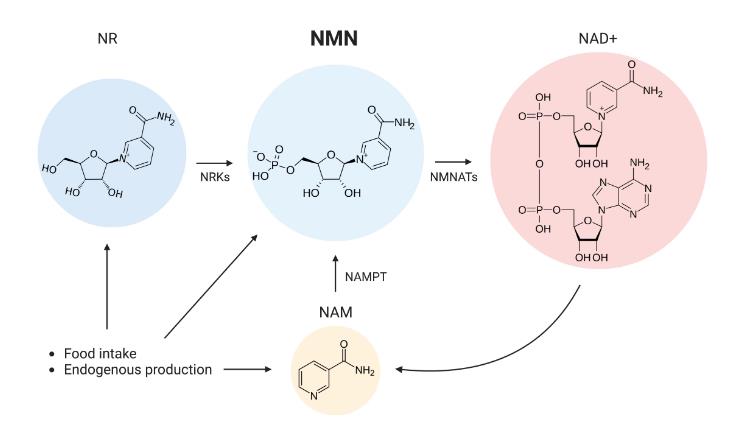The Science Behind NMN Ingredient: True NAD+ Booster for Anti-aging

What Is NMN?
NMN or nicotinamide mononucleotide is a safe and efficient precursor to NAD+, the essential coenzyme and key metabolite found in every cell of the human body, and involved in over 500 different cellular reactions.
Read on to explore what NMN is, how our bodies turn NMN into NAD+, and the benefits of NMN supplementation.If you need to buy NMN raw materials, please contact us.
Potential benefits of NMN
NMN is quickly absorbed and converted into NAD+ when taken orally. NMN supplementation has been shown to promote NAD+ production, reduce inflammation, promote insulin secretion and function, improve neurodegenerative conditions, help with diabetes and heart health, and have many other benefits. NMN supplementation can be effective and have positive benefits on a variety of physiological processes too. For all these purposes, the key lies in the science behind NMN.
Given NMN’s advantages for human health, some scientists think taking NMN supplements can slow down the consequences of aging. Some even claim that NMN, at least as demonstrated in animal models, is the traditional “fountain of youth.”
NAD+ is thought to control the synthesis of a protein that protects cells from oxidative stress and impairment of mitochondrial function. A number of neurological conditions, including dementia, and Alzheimer’s disease, are linked to these cellular stresses. High blood NAD+ levels have been found to significantly increase muscle strength, endurance, and function in older mice, according to studies.
[xxid]1,6[/xxid]
NMN production
An enzyme called NAMPT (nicotinamide phosphoribosyltransferase) transforms NAM into NMN. It is a rate-limiting enzyme in mammals that is present in both intracellular (iNAMPT) and extracellular form (eNAMPT). NMN is naturally found in food in broccoli, avocado, cucumber, cabbage, and more. Through food, there are small amounts of NMN. However, in mammals, NMN is produced from vitamin B3 as NAM.
The adipocytes, leucocytes, hepatocytes, monocytes, cardiomyocytes, and glia cells can synthesize eNAMPT. In both mice and humans, eNAMPT drastically decreases with age. Increasing NAD+ levels in several tissues improve their functioning and extend the lifespan of female mice by raising the levels of circulating eNAMPT.
In addition, NMN and NR work together. An enzyme called NRK transforms NR into NMN. NMN and NR have very identical molecular structures. However, NMN has an additional phosphate group, which makes NMN a bigger molecule than NR. Some researchers think NMN must be converted to NR before entering cells, where NAD+ production occurs because it is too big to pass through cellular membranes. If not, an NMN-specific transporter, such as Slc12a8, would be required to deliver NMN into cells.
Healthy aging with NMN
Our organs damage and gradually weaken as we age, leaving us more vulnerable to illness. For this reason, many scientists are now focused on developing strategies for slowing down, preventing, or even reversing aging. Anti-aging treatments could make age-related illnesses less common and prolong our lives while improving our health. Given its crucial function in various cellular processes, increasing NAD+ with NMN may positively affect practically all physiological systems.
Experiments on mice have shown that NMN can delay the muscular-skeletal problems that occur in old age and positively affect liver function. In addition, NMN is associated with improved metabolism, slower reduction of bone density, and improved vision loss in old age. Furthermore, NMN increases insulin’s glucose uptake capacity, increasing muscle sensitivity in prediabetic women. However, studies are continuously being conducted since there is a gap in our understanding of how NMN can affect and manage diabetes in people.
Alzheimer’s disease, which causes memory loss, is one of the most severe age-related disorders. NMN reduces brain plaques and neurodegeneration in Alzheimer’s mice and enhances cognition in mice with this disease. As the condition progresses, the symptoms can be worse. NMN has been shown to protect problems with learning, remembering, and thinking clearly.
Another study claim that NMN can protect the heart and its function. Ischemia happens when the blood vessels are clogged and damaged due to a lack of oxygen. NMN protects the heart against ischemic cardiac damage in mice. Giving NMN 30 minutes after ischemia reduces and normalizes the NAD+ levels. Treatment with NMN restores normal circulatory function and enhances the utilization of cardiac energy.
Numerous studies have revealed that NMN significantly reduces cancer cell proliferation and extends cell life. Researchers are looking at the CAR-T (chimeric antigen receptor T) cell therapy for NMN in that situation. While immunotherapies may soon replace chemotherapy as a cancer treatment option, chemotherapies are still the best-known therapy despite numerous adverse effects. These undesirable side effects, like cognitive impairments and heart damage in mice, have been minimized with NMN.
NMN is stable in water and is quickly absorbed when given orally. With this route of administration, plasma NMN levels increased in mice after two and a half minutes, continuously increasing after several minutes. NMN has been absorbed quickly in the gut too. Long-term NMN administration has been found to be safe and well-tolerated in mice when given 300mg/kg.
Final thoughts
These findings so far have been conducted on mice, so the benefits and effects of NMN in humans remain unclear. The scientists are working on human trials, as well as David Sinclair, who also is taking NMN by himself. He also claims that NMN enhances your energy levels and also blood parameters. There are few published findings on the long-term safety and therapeutic effectiveness of NMN’s anti-aging benefits in humans. Ongoing trials focus on evaluating the biological and physiological functions of NMN supplementation.





Leave a reply